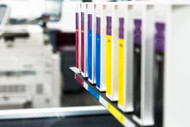Understanding the Different Types of Ink Cartridges: Dye vs. Pigment
When it comes to ink cartridges, there are two main types of ink formulations: dye-based and pigment-based. Understanding the differences between these two types can help you make informed decisions about which ink cartridge is best suited for your printing needs. Let's explore the characteristics, advantages, and considerations of each type.
Dye-Based Ink Cartridges: Dye-based ink cartridges contain liquid inks that are made up of colorants dissolved in a liquid solvent. Here are some key features of dye-based ink cartridges:
- Color Vibrancy: Dye-based inks are known for their vibrant and vivid colors. The dyes used in these inks are designed to produce rich and eye-catching prints, making them ideal for high-quality photo printing and color-intensive documents.
- Quick Drying Time: Dye-based inks have a fast drying time, which means that prints using these inks dry almost instantly. This is particularly advantageous for high-volume printing or when you need to handle prints immediately.
- Wide Color Gamut: Dye-based inks typically offer a wider color gamut, meaning they can reproduce a broader range of colors. This allows for more accurate color representation, making them popular among photographers and graphic designers.
- Susceptibility to Fading: One of the drawbacks of dye-based inks is their susceptibility to fading over time. Exposure to UV light and environmental factors can cause the colors to fade, making them less suitable for long-term archival prints or documents that require extended longevity.
Pigment-Based Ink Cartridges: Pigment-based ink cartridges contain microscopic solid particles, or pigments, suspended in a liquid carrier. Here are some key features of pigment-based ink cartridges:
- Longevity and Resistance to Fading: Pigment-based inks are known for their excellent longevity and resistance to fading. The solid particles in these inks are more resistant to UV light and environmental factors, making them a preferred choice for archival prints or documents that require long-term durability.
- Water and Smudge Resistance: Pigment-based inks have higher water and smudge resistance compared to dye-based inks. This makes them ideal for documents that may come into contact with moisture, such as important contracts, labels, or outdoor signage.
- Enhanced Text Print Quality: Pigment-based inks typically offer sharper and crisper text prints, making them suitable for professional documents, reports, and business correspondence.
- Slower Drying Time: Pigment-based inks generally have a slower drying time compared to dye-based inks. This can be advantageous in some cases, as it reduces the risk of clogged print heads, particularly for infrequently used printers.
Considerations: When choosing between dye-based and pigment-based ink cartridges, it's important to consider your specific printing needs:
- If you prioritize vibrant colors and photo printing, dye-based inks are a suitable choice.
- If longevity, fade resistance, and water resistance are important, pigment-based inks are the better option.
- Consider the intended use of your prints, such as whether they are for short-term use or long-term archival purposes.
- Take into account the drying time and the potential impact on your printing workflow.
It's worth noting that different printer models are designed to work optimally with a specific type of ink cartridge. Consult your printer's manual or manufacturer's guidelines to ensure compatibility between the printer and the type of ink cartridge you choose.
In conclusion, dye-based ink cartridges offer vibrant colors and quick drying times, while pigment-based ink cartridges provide longevity, fade resistance, and water resistance. Understanding the characteristics and considerations of each type will help you select the most appropriate ink cartridge for your specific printing requirements.





